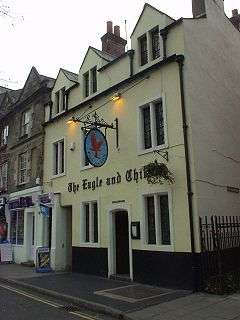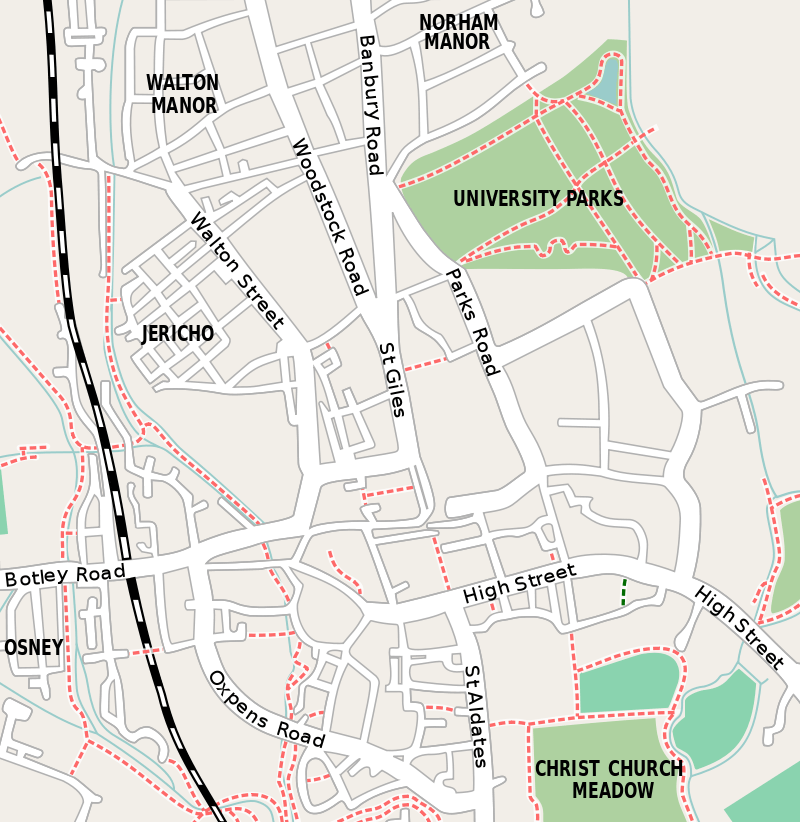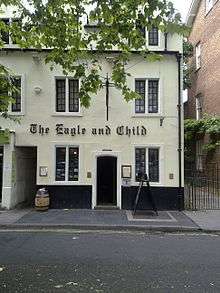The Eagle and Child
| The Eagle and Child | |
|---|---|
 The Eagle and Child | |
 Location within Central Oxford | |
| General information | |
| Coordinates | 51°45′26″N 1°15′37″W / 51.7572°N 1.2603°WCoordinates: 51°45′26″N 1°15′37″W / 51.7572°N 1.2603°W |
The Eagle and Child, nicknamed The Bird and Baby,[1] is a pub in St Giles' Street, Oxford, England, owned by St. John's College, Oxford. The pub had been part of an endowment belonging to University College since the 17th century. It has associations with the Inklings writers' group which included J. R. R. Tolkien and C. S. Lewis. In 2005, 25 other pubs had the same name.[2]
History

A small, narrow building, the pub reputedly served as the lodgings of the Chancellor of the Exchequer during the English Civil War (1642–49), when Oxford was the Royalist capital. The landmark served as a pay house for the Royalist army, and pony auctions were held in the rear courtyard. These claims are inconsistent with the earliest date usually given for construction of the pub, 1650, and the fact that the pub lies outside the city walls may also give some cause for doubt.
The first record of the pub's name is from 1684,[3] and is said to derive from the crest of the Earl of Derby. The image is said to refer to a story of a noble-born baby having been found in an eagle's nest.[4]
An alternative explanation for the name of the pub is from the star constellation 'Aquila and Antinous'. [5] [6]
The constellation was created by the Roman emperor Hadrian in 132. According to legend, Hadrian was told by an oracle that only the death of his most beloved person would save him from a great danger.
Antinous (pronounced ‘anti-no-us’) was the boy lover of the Roman Emperor Hadrian and hence is a real character, not a mythological one, although the story reads like fiction. Antinous was born c. AD 110 in the town of Bythinium (also called Claudiopolis), near present-day Bolu in north-western Turkey. At that time this area was a Roman province, and Hadrian is thought to have met Antinous during an official visit. Hadrian, the first openly gay Roman Emperor, was smitten by the boy and groomed him to become his constant companion.
Hadrian's happiness did not last long, though. While on a trip up the Nile in AD 130, Antinous drowned near the present-day town of Mallawi in Egypt. Supposedly the oracle had predicted that the Emperor would be saved from danger by the sacrifice of the object he most loved, and Antinous realized that this description applied to him.
Whether the drowning was accident, suicide, or even ritual sacrifice, Hadrian was heartbroken by it. He founded a city called Antinoöpolis near the site of the drowning, declared Antinous a god, and commemorated him in the sky from stars south of Aquila, the Eagle, that had not previously been considered part of any constellation.
One interpretation could therefore be that Aquila the Eagle (representative of the Roman Empire) is a metaphor for Emperor Hadrian.
The constellation's first known depiction was in 1536 on a celestial globe by the German mathematician and cartographer Caspar Vopel (1511–61); it was shown again in 1551 on a globe by Gerardus Mercator. Tycho Brahe listed it as a separate constellation in his star catalogue of 1602 and it remained widely accepted into the 19th century, when it was eventually remerged with Aquila.
The pub's long-standing nickname is the Bird and Baby, although other variants such as the "Fowl and Foetus" have been used.[1]
The pub had been part of an endowment belonging to University College since the 17th century. The college placed it on the market for £1.2 million in December 2003, saying that it needed to rebalance its property portfolio. It was bought by the nearby St John's College, which also owns the Lamb and Flag pub opposite.[3]
Literary connections
.jpg)
The Inklings was an Oxford writers' group which included C. S. Lewis, J. R. R. Tolkien, Charles Williams and Hugo Dyson. From late 1933, they met on Thursday evenings at Lewis's college rooms at Magdalen, where they would read and discuss various material, including their unfinished manuscripts.[7] These meetings were accompanied with more informal lunchtime gatherings at various Oxford pubs which coalesced into a regular meeting held on Monday or Tuesday lunchtimes at the Eagle and Child, in a private lounge at the back of the pub known as the 'Rabbit Room'.[8]
The formal meetings ended in October 1949 when interest in the readings finally petered out, but the meetings at the Eagle and Child continued, and it was at one of those meetings in June 1950 that C.S. Lewis distributed the proofs for The Lion, the Witch and the Wardrobe.[9]
The membership of the Inklings changed over the years, Tolkien, for example, drifted away from the meetings in the late 1950s.[10] But Lewis, who had lived around Oxford since 1921, was a central figure until his death in 1963. The Eagle and Child was modernised in 1962, with the pub being extended to the rear. The Rabbit Room's former privacy was inevitably destroyed leading to the group's reluctant change of allegiance to the Lamb & Flag at the other side of St Giles.[11]
More recently, the pub was regularly frequented by Colin Dexter,[12] who created Inspector Morse.
Notes
- 1 2 Edwards, A. (31 December 2005), "Pint to Pint: The Eagle and Child", The Daily Telegraph
- ↑ Cocker, Mark; Mabey, Richard (2005). Birds Britannica. Chatto & Windus. p. 474. ISBN 0-7011-6907-9.
- 1 2 Eagle & Child Inn, 49 St Giles, Oxford, www.oxfordhistory.org.uk, retrieved 15 July 2008
- ↑ Stanley crest history, Rootsweb, retrieved 14 May 2006
- ↑ http://www.ianridpath.com/startales/antinous.htm
- ↑ http://www.ianridpath.com/
- ↑ Duriez (2003) p80
- ↑ Duriez (2003) pp 77–80
- ↑ Duriez (2003) p128; ibid p137
- ↑ Duriez (2003) p160
- ↑ Carpenter (1978) p250; Brind (2006) p43
- ↑ "Oxfordshire - Pubs and Inns with a literary connection". Once Upon a Pint. Retrieved 29 July 2018.
References
- Brind, R.K. (2005), A guide to the C.S. Lewis Tour in Oxford, London: Janus
- Carpenter, H. (1979), The Inklings: C.S. Lewis, J.R.R. Tolkien, Charles Williams, and their friends, Ballantyne
- Duriez, C. (2003), Tolkien and C.S. Lewis: the gift of friendship, Mahwah, NJ: Hidden Spring
- Edwards, B.L. (2007), C.S. Lewis: an examined life, Westport, CT: Praeger
External links
| Wikimedia Commons has media related to Eagle and Child, Oxford. |